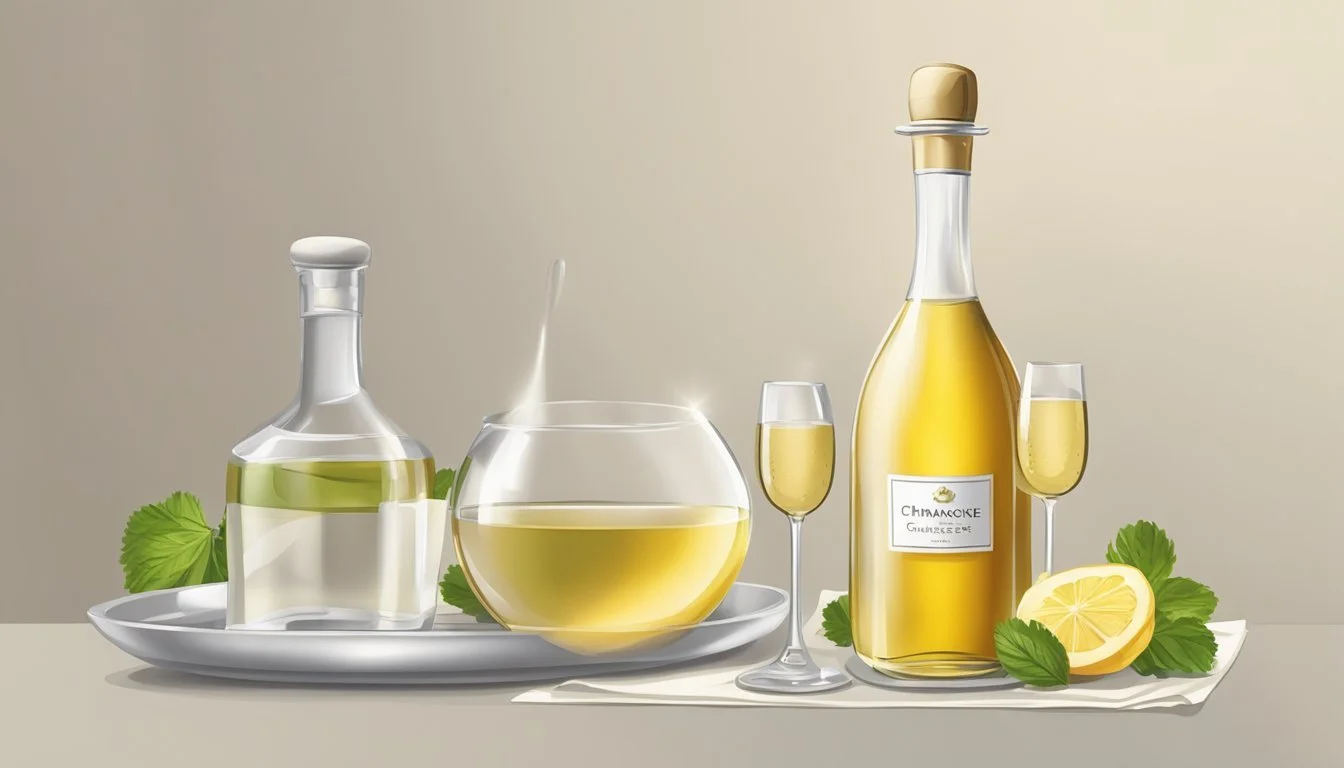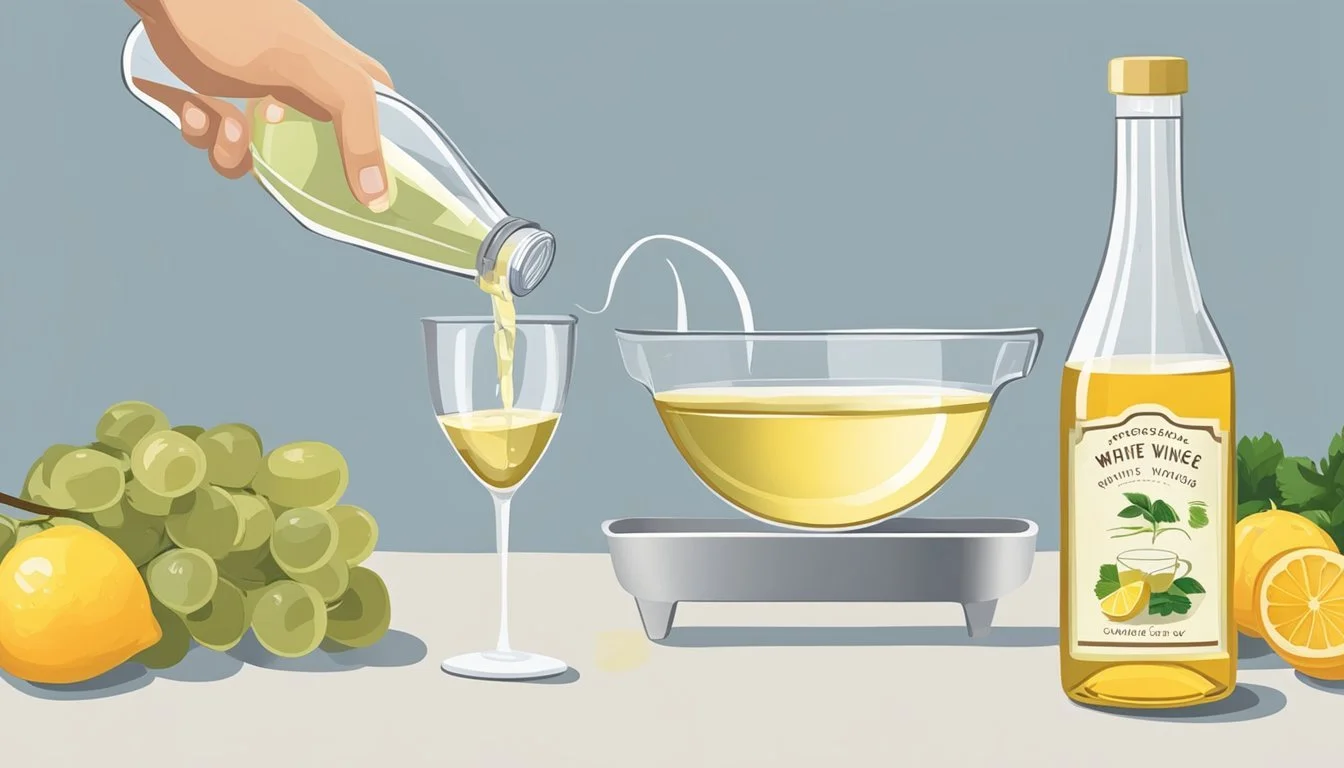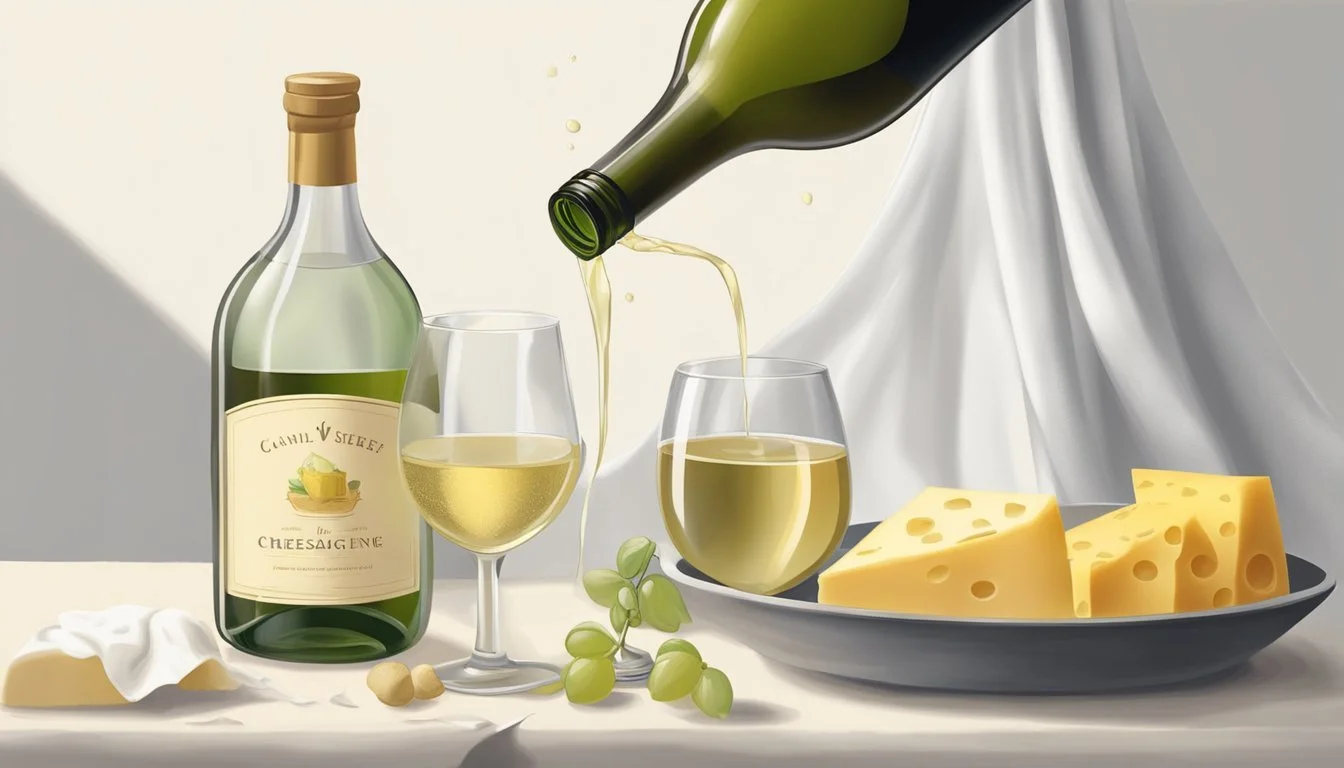How to Substitute Champagne Vinegar for White Wine Vinegar
Easy Swap Guide
Substituting champagne vinegar with white wine vinegar is a common culinary practice, given the occasional difficulty in sourcing the former. Champagne vinegar, known for its delicate and mildly acidic flavor, is a staple in French cuisine and often used in light vinaigrettes, sauces, and marinades. When it isn't available, white wine vinegar, which possesses a similar flavor profile with a slightly more pronounced acidity, serves as an excellent alternative. The process of substitution is straightforward, ensuring that recipes retain their intended taste and quality.
Both champagne and white wine vinegars are products of fermentation, which imbue them with their distinct flavors. While they share a fruit-based origin, their nuances are important in the context of cooking. Considered a versatile ingredient, white wine vinegar can confidently replace champagne vinegar in equal amounts in most recipes without compromising the dish's balance. This ensures chefs and home cooks can proceed with their preparation without undue concern.
Adept substitution hinges on understanding the flavor dynamics of both vinegars. White wine vinegar's robustness can be tempered with water or sugar when used as a substitute for the milder champagne variety. This simple adjustment preserves the sophistication of the dishes that require the light touch of champagne vinegar. Chefs can therefore make ingredient swaps with the assurance that the integrity of their culinary creations will be maintained.
Understanding Acidity and Flavor Profiles
In substituting vinegars, it is crucial to consider both the acidity and the flavor profiles to ensure culinary harmony. This section will dissect the essential characteristics of vinegars, focusing on acidity levels and the subtleties of flavor that set them apart.
Exploring Vinegar Variety
Vinegar is a staple in many cuisines, known for its acidic punch and ability to enhance flavors. Two common types—champagne vinegar and white wine vinegar—share similarities yet possess distinct profiles. Champagne vinegar, made from champagne, is noted for its light, delicate, and fruity flavor. In contrast, white wine vinegar, derived from white wine, tends to have a slightly sharper tangy flavor. Each vinegar brings its unique zest to dishes, influencing the taste and overall balance of the culinary creation they're used in.
Acidity in Cuisine
Acidity plays a pivotal role in cooking, adding brightness and lifting other flavor notes. The acidity of vinegar is often measured in pH, with most vinegars typically ranging between 2.4 to 3.4 on the pH scale. Here's a simple comparison of acidity levels:
Type of Vinegar Acidity (approximate pH) White Wine Vinegar 2.5 - 3.5 Champagne Vinegar 2.6 - 3.8
Although both types of vinegar maintain a similar acidity range, the difference lies in how they interact with other ingredients. White wine vinegar's pronounced acidity can be tempered when substituting with champagne vinegar, which may be preferred for a subtler touch. In any recipe calling for vinegar, a chef must assess whether the intended sharpness and flavor complexity align with the chosen substitute, ensuring that the end result honors the dish's original intention.
The Role of Champagne Vinegar in Cooking
Champagne vinegar plays a crucial role in culinary applications due to its delicate flavor and ability to enhance dishes without overwhelming them.
Champagne Vinegar Characteristics
Champagne vinegar, derived from the same grapes used in the production of Champagne, is valued for its light, floral, and slightly tart flavor. Its moderate acidity, typically around 5-7%, imparts a clean and crisp taste that is less intense than white wine vinegar. Champagne vinegar is often preferred for its ability to subtly accentuate flavors in a recipe rather than dominate them.
Common Uses in Dishes
In the realm of cooking, chefs frequently use champagne vinegar to create balanced vinaigrettes that complement rather than mask the flavors of salad greens. The vinegar's understated profile also works well in marinades, where it tenderizes proteins without overpowering them. Additionally, its contribution to sauces is significant, providing a mellow tartness that can uplift the dish without altering its intended flavor notes. Whether emulsifying a sauce or adding a bright touch to dishes, champagne vinegar is a kitchen staple that offers versatility and refinement.
White Wine Vinegar and Its Uses
White wine vinegar, a clear to pale gold vinegar, emerges from the fermentation of white wine. It has a milder taste compared to its red counterpart and is a versatile condiment often found in kitchens.
Common Uses:
Salad Dressings: It serves as a base in various dressings, imparting a tangy flavor that is not overpowering.
Cooking: Chefs use it to enhance sauces, marinades, and even soups.
Pickling: Its acidity makes it ideal for pickling vegetables, preserving them while adding flavor.
In Pickling:
White wine vinegar's acidity level, typically around 5-7%, ensures a safe environment for pickling, inhibiting bacterial growth while infusing the vegetables with a zesty taste.
In Cooking:
It acts as a subtle acidulant, which helps in tenderizing meats and brightens the flavors of dishes without dominating them. It's particularly useful in deglazing pans to create flavorful pan sauces.
In Salad Dressings: Because of its lighter flavor profile, it complements rather than competes with the taste of fresh salad ingredients. Its versatility allows for pairing with various oils and seasonings for balanced and nuanced dressings.
Key Characteristics:
Flavor: Mildly tangy and slightly less acidic than other vinegars.
Color: Pale yellow to clear.
Acidity: Approximately 5-7%, ideal for many culinary uses.
Chefs and home cooks alike rely on white wine vinegar for its flavor-enhancing properties, making it a staple for various applications in the kitchen.
Selecting Suitable Substitutes for White Wine Vinegar
When searching for a substitute for white wine vinegar, it is critical to consider how a similar flavor and acidity can be achieved to maintain the intended balance of a dish.
Matching Flavor and Acidity
White wine vinegar is favored for its balanced acidity and subtle fruity flavor. A suitable substitute should match these characteristics as closely as possible to retain the profile of the original recipe.
Red Wine Vinegar: Possesses a similar grape-based origin and acidic level; however, it carries a more robust flavor.
Apple Cider Vinegar: Offers a fruit-forward taste. Its acidity is compatible, but the apple undertones can be distinctive.
Rice Vinegar: Exhibits a milder taste and less acidity. It is especially well-matched in light sauces and salad dressings.
Lemon Juice: Can mimic the acidity with a refreshing zest, suitable for vinaigrettes. It is best used in a 1:1 ratio.
One should carefully adjust these substitutes, considering that each has its unique flavor notes which can affect the taste of the final dish. They should start with a conservative amount and add more as needed.
Substitute Options for Different Dishes
Certain substitutions may work better in specific types of dishes. Here are recommendations tailored to different culinary applications:
Salad Dressings and Marinades:
Red Wine Vinegar works well as a 1:1 substitute.
Lemon Juice can be a refreshing alternative in vinaigrettes.
Cooked Sauces and Stews:
Apple Cider Vinegar or Sherry Vinegar can be used, diluted with water to match the less aggressive profile of white wine vinegar.
Light Sauces and Seafood Dishes:
Rice Vinegar is ideal due to its subtle flavor, though additional acidity may be required.
One must consider how the substitute will interact with other ingredients and whether the final dish should taste precisely as intended or if a slight variation in flavor is acceptable.
Guidelines for Substituting Champagne Vinegar
When a recipe calls for white wine vinegar and it's not available, champagne vinegar is an excellent substitute due to its similar flavor profile and acidity. The following guidelines will ensure the best outcomes when using champagne vinegar as a replacement.
Adjusting Ratios and Quantity
Equal Ratio: Replace white wine vinegar with champagne vinegar in a 1:1 ratio.
Dilution: If the champagne vinegar is particularly strong, it may be diluted with water, though this is typically not necessary.
Considerations for Recipe Success
Acidity: Champagne vinegar generally has a bit less acidity than white wine vinegar, so tasting and adjusting might be required.
Sugar Content: For dressings or sauces that benefit from a hint of sweetness, champagne vinegar's subtle sweetness can enhance the recipe without additional sugar.
Color: It is usually lighter in color than white wine vinegar, which should be considered for the final presentation of dishes.
Recipe Adaptations with Champagne Vinegar
When a recipe calls for champagne vinegar and it is not available, white wine vinegar can be a suitable alternative due to its similar fruity and tangy flavor profile. It can be used in the same quantity as champagne vinegar—meaning, a 1:1 substitution ratio is appropriate for most recipes.
For Vinaigrettes and Salad Dressings
Champagne vinegar is known for its light and elegant flavor, which makes it an excellent choice for vinaigrettes and salad dressings. To maintain the character of the dressing when using white wine vinegar instead, it's advisable to mix:
1 tbsp white wine vinegar
1/4 tsp water (optional, to dilute the acidity)
Pinch of sugar (optional, to mimic the slight sweetness of champagne vinegar)
This slight adjustment ensures the dressing remains balanced and does not overpower the salad's fresh ingredients.
For Marinades
Marinades benefit from the acidity of vinegar to tenderize and add flavor to proteins. When substituting in marinades, directly replace champagne vinegar with white wine vinegar in equal measures. The similarly crisp acidity preserves the intended flavor dynamics.
For Béarnaise Sauce
The delicate flavor of champagne vinegar is essential in béarnaise sauce. If using white wine vinegar, consider reducing the amount slightly and taste-test to ensure the bolder vinegar does not dominate the sauce's nuanced flavors.
Ingredient in Recipe Substitute with Champagne Vinegar White Wine Vinegar (equal part) Extra Considerations Add water/sugar as necessary for taste adjustment
Using white wine vinegar as a stand-in for champagne vinegar is generally successful when these guidelines are followed. It offers cooks the flexibility to achieve a desirable taste in their dishes, even if they must swap out certain ingredients.
Cultural Context of Vinegar
In various cultures, vinegar is not only a condiment but a culinary staple with a rich history and diverse applications in cooking. Its use reflects the dietary customs and traditional practices of each region.
Vinegar in Mediterranean Cuisines
In Mediterranean cooking, particularly in countries like Italy and Spain, vinegar holds a revered place. Italian cuisine, known for its emphasis on fresh and high-quality ingredients, frequently incorporates balsamic vinegar, an aged and richly flavored variety that originated in Modena. Balsamic vinegar is characteristically syrupy, sweet, and tangy, making it a perfect complement to salads (What wine goes well with salads?), marinades, and even desserts.
On the other hand, Spanish cuisine makes extensive use of sherry vinegar. Originating from the Jerez region, this vinegar is known for its bold and nutty flavors. It features prominently in gazpacho, a cold soup that is emblematic of Spanish cuisine, as well as in various marinades and dressings.
Italy: Balsamic Vinegar
Sweet and tangy
Used in salads, marinades, desserts
Spain: Sherry Vinegar
Bold and nutty flavor
Used in gazpacho, marinades, dressings
Vinegar in Asian Cooking
Asian cuisines exhibit a vast array of vinegar types, each imparting unique flavors to dishes. Rice vinegar, particularly prominent in East Asian cooking, has a milder taste and is less acidic compared to Western vinegars. This quality makes it an essential ingredient in sushi rice, as it seasons without overpowering the delicate flavor of the fish.
Moreover, in countries like China, black vinegar stands out. Characterized by its malty sweetness and smoky undertones, black vinegar is often used as a dipping sauce or in braised dishes (What wine goes well with braised dishes?). Its complexity adds depth to the Asian palate, which values balance and harmony in flavors.
East Asia: Rice Vinegar
Mild and less acidic
Essential in sushi rice
China: Black Vinegar
Malty sweetness, smoky undertones
Used in dipping sauces, braised dishes
DIY Vinegar Making
Creating homemade vinegar allows for a tailored approach to flavor profile and acidity, delivering a unique ingredient for culinary use. The fermentation process underpinning vinegar making is both an art and a science, transforming base ingredients into tangy, flavorful condiments.
Homemade Champagne Vinegar Process
To make homemade champagne vinegar, one requires champagne as the base. Here is the step-by-step approach:
Starting the Mother: Obtain a 'mother of vinegar', which is a live acetic acid bacteria culture, available online or from a previous batch of vinegar.
Sterilization: Sterilize the container by boiling it in water.
Adding Champagne: Pour the base champagne into the container, leaving some space at the top for air.
Combining with Mother: Add the 'mother' to the champagne. If unavailable, unfiltered raw vinegar can be used as a starter.
Covering the Container: Secure cheesecloth over the container's opening to keep out debris and allow air in, which is crucial for fermentation.
Fermentation: Keep the container in a dark, warm place around 60-80°F (15-27°C). This can take from a few weeks to several months. Regularly check the vinegar and begin taste-testing after four weeks.
Completion: Once the vinegar has reached the desired acidity, strain it and bottle it. The vinegar can be used immediately or aged for a more mellow flavor.
Cultivating Unique Vinegar Flavors
Experimenting with different base ingredients can produce distinctive vinegars, such as fruit or honey vinegar. Raspberry vinegar, for instance, involves the use of fresh raspberries during the initial fermentation, which imparts a fruity aroma and flavor.
Fruit Vinegars: Use fruit juice or pulp as the starting material. The natural sugars will ferment into alcohol and subsequently into acetic acid. For a homemade raspberry vinegar, mash raspberries into the base alcohol before adding the 'mother.'
Honey Vinegar: Utilize raw honey dissolved in water as the base. Honey vinegar requires a longer fermentation due to its lower sugar content compared to fruits.
Through the process of fermentation, different sugars in the base ingredients are transformed into alcohol, and then into the acetic acid that characterizes vinegar. Each ingredient, whether it's champagne, fruit, or honey, imparts its own unique profile to the final product.
Food Pairing with Vinegar-Based Sauces and Dressings
When it comes to enhancing the flavors of chicken, seafood, and fish, vinegar-based sauces and dressings can be a game-changer. These ingredients bring a bright, tangy note that can elevate the natural flavors of these proteins.
For Chicken:
Marinades: A mixture of champagne vinegar, olive oil, minced garlic, and herbs creates an excellent marinade that tenderizes the chicken and adds a layer of flavor.
Salad Dressings: Drizzle a vinaigrette made with champagne vinegar over a chicken salad for a light and refreshing twist.
For Seafood:
Dipping Sauces: A simple sauce combining champagne vinegar with shallots and mustard complements the delicate flavors of seafood.
Ceviche: Seafood marinated in a citrusy champagne vinegar mixture offers a bright and zesty profile.
For Fish:
Pan Sauces: After cooking the fish, deglaze the pan with champagne vinegar, then whisk in a stock reduction and finish with a pat of butter.
Dressings: Pairing fish with salad dressed in a champagne vinegar-based vinaigrette balances both the dish's richness and acidity.
Protein Preparation Suggested Sauce/Dressing Chicken Grilled/Roasted Herb-infused champagne vinegar marinade Seafood Steamed/Boiled Champagne vinegar dipping sauce Fish Pan-fried/Baked Champagne vinegar-based pan sauce
In sum, when substituting champagne vinegar for white wine vinegar, chefs should consider the subtle yet distinct flavor profile. This substitution should aim to complement the main ingredients without overwhelming them. The slight fruitiness and milder acidity of champagne vinegar make it a versatile component in creating harmonious sauces and dressings for a range of dishes.
Conclusion
In the realm of culinary arts, precise substitutions can make a world of difference, ensuring flavors are beautifully mirrored. Focusing on vinegar, it's clear that one can substitute champagne vinegar with white wine vinegar seamlessly in most cases.
Summarizing Vinegar Substitutions
White wine vinegar stands out as the primary alternative to champagne vinegar due to its similar acidic profile and fruity undertones. They both possess a comparable level of tanginess, making them largely interchangeable. For an accurate substitution, use a 1:1 ratio when replacing champagne vinegar with white wine vinegar in recipes.
Salad dressings: Achieve the desired zest by using equal parts of white wine vinegar in place of champagne vinegar.
Marinades: Ensure meats or vegetables retain their intended flavor by substituting in a like-for-like measure.
Sauces: Maintain the balance of flavors in culinary sauces with a direct exchange.
Encouraging Culinary Exploration
The essence of cooking lies in experimentation and discovery. While white wine vinegar is an excellent substitute for champagne vinegar, chefs are encouraged to explore other vinegars like sherry or rice vinegar, recognizing the subtle taste variances they bring. Each vinegar carries its unique attributes that can enhance a dish in different ways, thus expanding a cook's repertoire and sensory experience.








